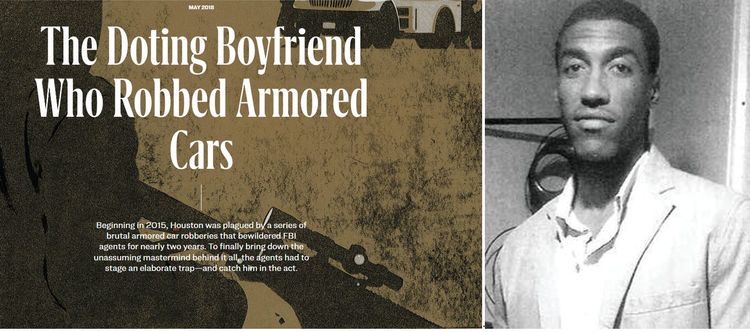From the Texas Monthly, a series of true crime articles about a Houston armored car robber who invented a new wrinkle to speed things up: just immediately kill the messenger carrying the bag of money without asking him to put his hands up.
The Doting Boyfriend Who Robbed Armored Cars
Beginning in 2015, Houston was plagued by a series of brutal armored car robberies that bewildered FBI agents for nearly two years. To finally bring down the unassuming mastermind behind it all, the agents had to stage an elaborate trap—and catch him in the act.
BY SKIP HOLLANDSWORTH
DATE APR 18, 2018
![]() In September 2016, when FBI agents first started tailing Redrick “Red” Batiste, he seemed to be an ordinary young man leading an ordinary life. Batiste was 36 years old, tall and slim, with dark eyes and an easy smile. He lived with his two bulldogs in a two bedroom, 956-square-foot house in Acres Homes, a modest neighborhood twelve miles north of the skyscrapers of downtown Houston.
In September 2016, when FBI agents first started tailing Redrick “Red” Batiste, he seemed to be an ordinary young man leading an ordinary life. Batiste was 36 years old, tall and slim, with dark eyes and an easy smile. He lived with his two bulldogs in a two bedroom, 956-square-foot house in Acres Homes, a modest neighborhood twelve miles north of the skyscrapers of downtown Houston.
By most indications, he was exceedingly straitlaced. He dressed well, usually wearing pullover polo shirts and tightly belted cargo pants. Once a week, he went to a barbershop to get a haircut and a manicure. He was so meticulous about keeping his house clean that he asked visitors to take off their shoes before coming inside so they wouldn’t track dirt across the carpet. …
Every year, there are between 25 to 35 attempted armored car robberies in the United States. By comparison, approximately 4,000 banks are robbed in the same span. There’s a simple reason for this glaring difference: there is far less peril in robbing a bank than an armored car. …
A criminal who robs an armored car, however, knows he’s putting his life on the line. Drivers and messengers for armored car companies are not paid to be amicable. “The employees have been trained to use deadly force the moment they believe they are in imminent danger of bodily harm,” says Jim McGuffey, a security consultant who spent 26 years working in the armored car industry. “That’s standard practice. They don’t have to wait for the robber to shoot first.”
Still, the greater the risk, the greater the reward. Bank robbers are lucky to escape with a few thousand dollars from a teller’s drawer, but it’s not unusual for a messenger to carry tens of thousands of dollars or more in the coal bags. ..
![]() |
| Murdered guard Alvin Kinney |
But Kinney’s brutal murder was a rarity: the first time since 2002 that a Houston armored car employee had died in the line of duty. And it was not just a killing. It was a cold-blooded execution. Kinney hadn’t even been given a chance to surrender.
They appear to have pulled off at least 4 armored car robberies in this shoot-first fashion, murdering 3 couriers and leaving one wounded.
![]() |
| Murdered guard David Guzman |
In the later robberies, Batiste switched to a Beltway Sniper-mode where he’d shoot the armored car worker with a rifle from the back of a vehicle across the street.
He also had a clever technique for stealing cars that you can read about in the magazine.
And a follow-up article in Texas Monthly a year later:
What Drove Houston’s Armored Car Robber to Cold-Blooded Crime?
New insights about Redrick “Red” Batiste emerge after his accomplices are found guilty.
BY SKIP HOLLANDSWORTH
APR 5, 2019
I’m not sure I’ve ever come across a criminal as diabolical and ruthless as Houston’s Redrick “Red” Batiste, who robbed armored cars and murdered the couriers with a sniper rifle. When I first wrote about him in the May 2018 issue of the magazine, though, I couldn’t quite answer one of the central questions: What led him to turn from a strait-laced good neighbor and dad to a chillingly meticulous murderer and robber straight out of a Michael Mann movie? …
![]() |
| Murdered guard Melvin Moore |
Although he had committed minor crimes as a young man, he hadn’t been charged with any violent crimes except for a couple of misdemeanor assault charges. Nor had he been arrested for any crime at all since 2009. People told me that during those years between 2009 and 2015, Batiste strove to make a legitimate name for himself. “But if you are young and black, dressing nice and driving a nice car, everything you do is policed, especially if you are living in the poor Acres Homes neighborhood,” said one of his Acres Homes buddies, who asked that his name not be published. “That was Red. The police were always pulling him over, thinking he was up to some shit. When he’d tell them that he was trying to improve the neighborhood, they’d just laugh and pat him down. He was always getting profiled, getting harassed, and the cops didn’t care.”
One longtime resident of Acres Homes, 81-year-old Tommy Albert, who had known Batiste since he was a boy, recalled an afternoon they were leaving a barbecue restaurant. “We were getting into Red’s $75,000 Jeep with four-wheel drive, everything loaded up, and the police pulled up, blocking Red’s way out, and he said, ‘Why are you cops fucking with me?’ Well, that got them mad and they made him get on the ground wearing his nice clothes. And they put their knees in his back and took him to jail on some false charges. He had to spend money on a lawyer to get the charges dropped. I remember Red told me, ‘These sons of bitches smile in your face and stab you in the back.’ I said, ‘Now, Red, not all the police are like that.’ But I could see this anger in his face.”
Albert also said that Batiste was growing more and more upset that banks wouldn’t loan him money for his real estate projects. “He wasn’t trying to build a skyscraper—just a little store. And the bankers would give Red a look—this young black male with no college degree—and they’d say no. Or they’d want to have a white man co-sign on the note. Red would say to me, ‘You can’t win in this society. You can’t win.’”
When I interviewed Okoh [his girlfriend], who met Batiste in 2013, she insisted that he was always well-mannered around her, perfectly polite. But she too noticed an anger in him. In 2014 and 2015, he became fixated on the police shootings taking place around the country of unarmed black males, like 12-year-old Tamir Rice of Cleveland, Ohio, and 18-year-old Michael Brown of Ferguson, Missouri. “He would say the time was coming where he wouldn’t be able to turn the other cheek,” said Okoh. “But he never talked about killing anyone.”
… I talked to sources close to the FBI investigation who told me that Batiste had indeed been consumed by his sense, whether real or imagined, of racial injustice. Before committing his armored car robberies, he had begun reading the works of black writers who railed against white supremacy. He had bought guns that he hid throughout his house. And eventually, he had begun talking to a few of his friends about his desire to ignite a “race war.”
FBI agents who later searched Batiste’s computer found letters he had written to prison convicts who had murdered white cops, telling them that he appreciated what they had done. They came across a Facebook posting in which Batiste had worn a black mask over his face and ranted about living like a gangster, to “keep things real.”
FBI agents also came across evidence (they have yet to reveal exactly what it is) that led them to believe that Batiste had murdered a white man who owned several McDonald’s restaurants and that he had murdered Joseph Stewart, the well-known owner of Houston’s Stewart Cadillac, where Okoh worked as a saleswoman. The Stewart murder was front-page news in Houston. Late one night in May 2015, Stewart was returning to his townhome near Houston’s Montrose area when gunshots rang out. He was found dead, lying just outside his garage. An unknown man wearing a hooded sweatshirt had been seen running from the scene. According to one source I spoke to, Batiste was apparently angry at Stewart for not treating Okoh as well as he treated his white employees. (When I asked Okoh about Stewart’s murder, however, she insisted that she had no problems at her job and that Batiste had nothing to do with Stewart’s shooting.)
The total number of homicides in the US went up over 24% from 2014 to 2016. One theory is that policemen were discouraged by all the animosity directed against them. But another would be that the Great Awokening encouraged black criminals, like this fairly intelligent guy, to be more homicidal.
[Comment at Unz.com]

















